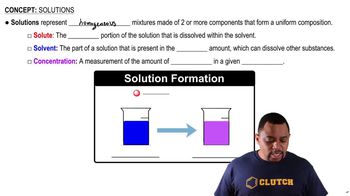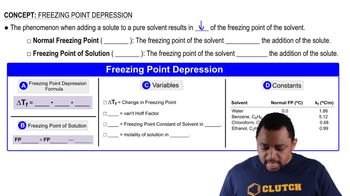Breathing air that contains 4.0 % by volume CO2 over time causes rapid breathing, throbbing headache, and nausea, among other symptoms. What is the concentration of CO2 in such air in terms of (b) molarity, assuming 1 atm pressure and a body temperature of 37 °C?
Ch.13 - Properties of Solutions
Chapter 13, Problem 62b
You make a solution of a nonvolatile solute with a liquid solvent. Indicate if each of the following statements is true or false. (b) The solid that forms as the solution freezes is nearly pure solute.
 Verified step by step guidance
Verified step by step guidance1
insert step 1> Identify the components of the solution: a nonvolatile solute and a liquid solvent.
insert step 2> Understand the process of freezing: as the solution cools, the solvent molecules begin to form a solid structure (crystal lattice).
insert step 3> Consider the nature of the solute: since it is nonvolatile, it does not easily escape into the vapor phase, but it can still be excluded from the solid structure formed by the solvent.
insert step 4> Recognize that during freezing, the solvent molecules preferentially form the solid phase, often excluding the solute molecules, leading to a solid that is nearly pure solvent.
insert step 5> Conclude that the statement is false because the solid that forms as the solution freezes is nearly pure solvent, not solute.

Verified video answer for a similar problem:
This video solution was recommended by our tutors as helpful for the problem above.
Video duration:
1mWas this helpful?
Key Concepts
Here are the essential concepts you must grasp in order to answer the question correctly.
Nonvolatile Solute
A nonvolatile solute is a substance that does not readily evaporate at room temperature and has a low vapor pressure compared to the solvent. When dissolved in a solvent, it affects the physical properties of the solution, such as lowering the freezing point. This property is crucial in understanding how solutes influence the freezing behavior of solutions.
Recommended video:
Guided course

Solution Components
Freezing Point Depression
Freezing point depression is a colligative property that describes how the addition of a solute to a solvent lowers the temperature at which the solvent freezes. This phenomenon occurs because solute particles disrupt the formation of the solid lattice structure of the solvent, requiring a lower temperature to achieve solidification. Understanding this concept is essential for predicting the behavior of solutions upon freezing.
Recommended video:
Guided course

Freezing Point Depression
Purity of Crystallized Solute
When a solution freezes, the solid that forms is typically composed of the solvent in a crystalline structure, while the solute remains dissolved in the liquid phase. In the case of a nonvolatile solute, the solid that forms is not pure solute; instead, it is primarily the solvent, with the solute remaining in the unfrozen solution. This concept is important for understanding the composition of solids formed from solutions.
Recommended video:
Guided course

Solution Components
Related Practice
Textbook Question
Textbook Question
You make a solution of a nonvolatile solute with a liquid solvent. Indicate if each of the following statements is true or false. (a) The freezing point of the solution is unchanged by addition of the solvent.
Textbook Question
You make a solution of a nonvolatile solute with a liquid solvent. Indicate if each of the following statements is true or false. (d) The boiling point of the solution increases in proportion to the concentration of the solute. (e) At any temperature, the vapor pressure of the solvent over the solution is lower than what it would be for the pure solvent.
Textbook Question
The vapor pressure of pure water at 60 °C is 149 torr. The vapor pressure of water over a solution at 60 °C containing equal numbers of moles of water and ethylene glycol (a nonvolatile solute) is 67 torr. Is the solution ideal according to Raoult's law?
